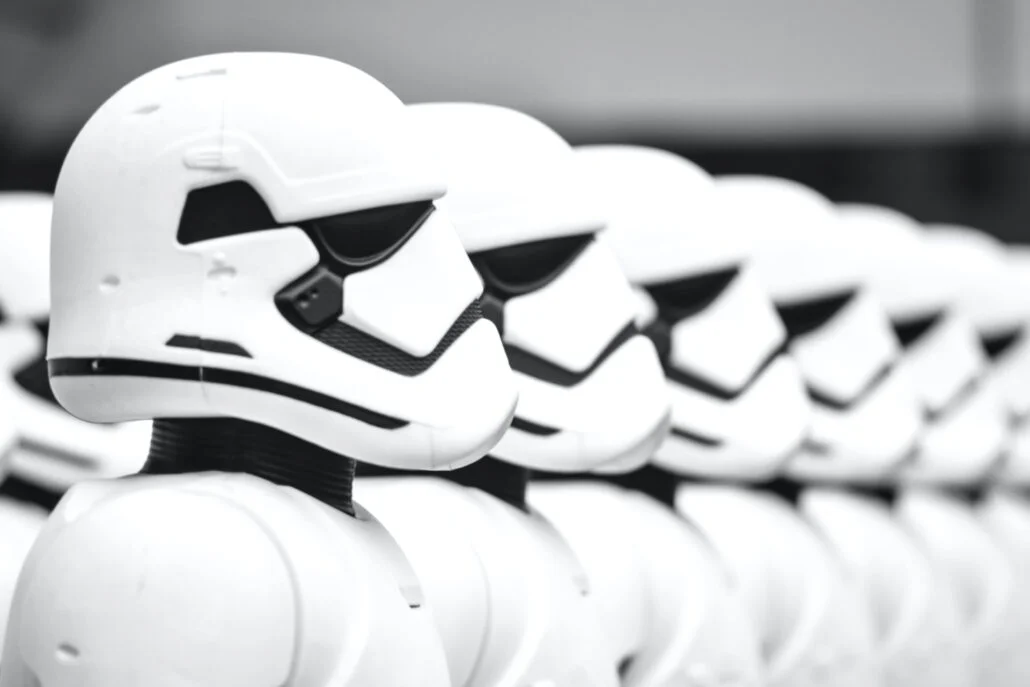
Stars Wars is on its second reboot these days. Even if you’re not a fan of the cinematic epic, you can appreciate the franchise. Once again, young and old alike are gripped by the narratives, anxious to see the films, buy the merchandise, and discuss it all – ad nauseum – through blogs, social media posts, and Instagram memes. Star Wars is a brand with staying power.
Way back in 1977 (I was just a baby!!), George Lucas launched the first installment of Star Wars, mesmerizing crowds with compelling stories, fresh faces, and innovative special effects. In short order, two additional films were released to rave reviews. In the 20+ years that followed, a billowing fan base waited for news of a sequel or two, fresh episodes that built upon the legacy of the original trilogy. Enter the Phantom Menace, the first of the Star Wars “prequels.” While Phantom Menace and the two prequals that followed had far more special effects firepower than the original films, the “magic” was absent. Dull and dark characters, complicated scripts, and tired action sequences rubbed the luster off the franchise. Even the most diehard Star Wars aficionados were asking themselves, “What the hell was that?”
Whether your selling trinkets or movie tickets, brand consistency is a must. Consistency doesn’t imply that you never improve your products or tweak your services, it means that you maintain the core qualities that put you on the map in the first place. Repeat business and brand loyalty is built upon trust. Betray your customers’ trust and they’ll take their loyalty somewhere else. When George Lucas and his Star Wars team decided to make the prequals darker and more complicated than the original movies, they forgot to ask the vital question, “Do the fans want this?” The answer – delivered through disappointing ticket sales and dismal movie reviews – was a resounding, “No!” Star Wars fans wanted the same fun, compelling, adventure story culminating in good kicking evil’s dark side, not psychological thrillers that peered into the motivations of the various heroes and villains. Trust betrayed. Remember that time Coke decided to launch “New Coke?” Same story. When New Coke only had a can and color in common with the original product, many consumers recoiled and changed their allegiance to Pepsi products. Having betrayed the trust of its customers, Coke made an about face and relaunched “Classic Coke.”
Now that I’ve made the case for brand consistency, let me share why and how it’s so applicable across the corporate continuum. Now, I am far from a marketing expert, but having led large business units and client and sales teams for two decades, I can confidently say that these apply across all facets of an organization and are not purely for marketers; they are for leaders developing or maintaining corporate culture, for client and sales teams who are the face of your brand, even for the individual themselves as they establish their own personal brand identity.
For starters, consistency creates the ability for measurement and I’m sure you’ve heard the saying “you can’t manage what you can’t measure”. Whether measurement is for social media impressions or employee engagement, consistency in messaging and actions lead to measurement to gauge its success. Secondly, consistency creates accountability – I ask my employees to be accountable for their deliverables and goals. They should expect the same in return from me. I make it a priority to provide time for and be available to my team. I work to establish consistent and recurring meetings when a project or aspect of the business requires attention. The simple fact that there is consistency and a set time to report on measured progress is often the catalyst that drives success.
Next, consistency establishes your reputation and leadership position. Consistency is one of the strongest traits among the world’s greatest leaders – whether good or bad, positive or negative – provides the business, its employees, and stakeholders with a known quantity. And more than anything, people respect and admire consistent leaders. Business growth requires a track record of success; you employees and your customers need predictable results and communication from you. You can’t establish a track record if you are constantly shifting gears or trying new tactics. Many efforts fail before they get to the finish line, but not because the tactic was flawed, or the goals weren’t clear. The problem is often that the team simply didn’t stay the course to achieve the objective. Too frequently, I see businesses or leaders, adopt a campaign or initiative only to end it before it gains traction. When something doesn’t work, I look back at what happened and ask some serious questions. Did we shift gears too quickly? Did part of the team not deliver on a commitment? Or was the expected outcome off base from the start? Most of the time, the reason tracks back to lack of consistency.
Ideally, your consistency in brand and reputation should be memorable and repeatable. When I say “swoosh” or “just do it,” you instantaneously think about the famous shoe brand. That’s style consistency at work. Even in the lean years of the Star Wars franchise, the franchise’s style was consistent. If moviegoers didn’t see the floating titles at the beginning of the film or hear the famous soundtrack as the curtain opened, there would be a public outcry.
Bottom line? You can innovate and transform your brand, but exercise caution when you rebrand, tweak your brand, or even start from scratch. Your customers are open to innovation so long as they can see how the innovation connects with the longstanding products and services and the value that made them fans of your brand, or of YOU, in the first place. This goes for your leadership and personal brand too. Take risks, but also safeguard the intrinsic qualities and approaches that make you stand out and be memorable. More about this in a future post…



